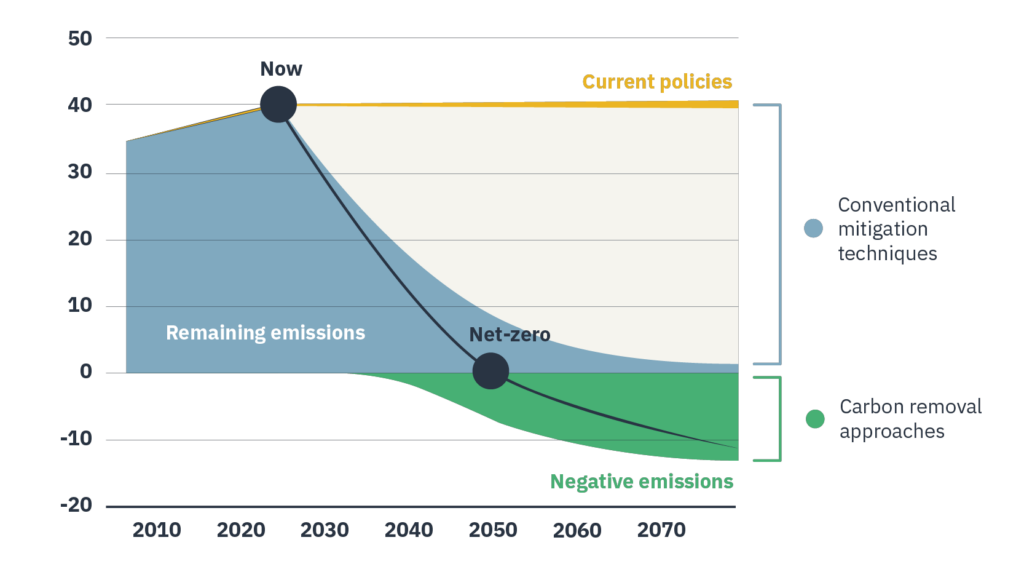The climate crisis is not a future concern; it’s a current issue that’s escalating quickly.
Each year introduces a new series of record heat waves, droughts, wildfires, floods, and storms. The uptick in extreme weather events makes it evident that prompt and straightforward action is needed for the well-being of future generations.
The pivotal goal of reaching net zero greenhouse gas emissions by 2050 must be pursued with great urgency. This transition will require a systematic overhaul of energy systems across the globe, with renewable solutions now readily available. The path forward will not be easy, but the decisions we make this decade will create a lasting impact for generations to come.
The science behind net zero goals
The necessity for net zero stems from extensive climate science. Atmospheric CO2 levels above 350 parts per million (ppm)1 is the key driver of rising global temperatures and increasing climate chaos. Current levels hover around 418 ppm and continue to rise. Recent IPCC reports underscore the importance of swift decarbonisation to stabilise the climate.
The IPCC 6th Assessment Report2 indicates that achieving net zero global emissions by 2050 offers humanity the best opportunity to limit future warming to 1.5°C, in line with the goals set by the Paris Agreement. This requires cutting emissions 45% by 2030 and reaching carbon neutrality by mid-century. Critically, current policies have us on track for a catastrophic 2.7°C rise by the end of the century3. There is no time left to delay – the window for action is fast closing.
Staying below 1.5 degrees of global warming

Planning for decarbonisation
Responding to the stark scientific evidence, over 70 countries have now pledged5 to reach net zero emissions by 2050, with many others setting interim goals of halving emissions by 2030. While the ambitions are noble, the implementation required to turn those commitments into reality entails economy-wide planning and rigorous follow-through.
Decarbonisation is not just a buzzword; it must be a structured process of steadily eliminating carbon across all sectors of the economy. Policymakers are focusing on granular, year-by-year deployment targets with coordination across industries. The UK’s comprehensive Net Zero Strategy6 exemplifies such meticulous planning – a model for other nations with its policies stretching across buildings, transport, power, and heavy industry.
Global adoption of net zero targets
The recent flurry of net zero pledges at the national level is certainly a good sight. However, these promises must now be backed up with systematic execution. Over 80% of global emissions are now nominally covered by national net zero goals4. But turning these into reality will require extensive public and private investments, estimated at $3.5 trillion per year7, along with transparency through detailed progress reporting and verifiable emissions cuts.
Energy investment needed: Annual energy capex needs, actual vs. estimates

Thousands of companies, cities, educational institutions, and investors have also made net zero pledges. Although a welcome idea, these currently seem more PR than policy, with only a small fraction having robust decarbonisation roadmaps and strategies, capital allocation plans, and rigorous tracking in place to achieve tangible real-world impact.
Conclusion
In conclusion, the climate crisis is an undeniable reality that calls for quick and firm action. This pursuit is not just a lofty goal; it’s an urgent necessity. The science is clear, and the consequences of inaction dire.
In part 2, we will delve deeper into the key drivers and players in the solution for achieving net zero. The path to a sustainable future is challenging, but it’s one we must tread with determination and unwavering commitment.
[4] World Resources Institute (2023) https://www.wri.org/insights/net-zero-ghg-emissions-questions-answered#:~:text=Bhutan%20was%20the%20first%20country,by%20a%20net%2Dzero%20target.
[5] United Nations (2023) https://www.un.org/en/climatechange/net-zero-coalition#:~:text=Yes%2C%20a%20growing%20coalition%20of,about%2076%25%20of%20global%20emissions.
[7] Energy Transitions Commission (2023) https://www.energy-transitions.org/publications/financing-the-transition-etc/#:~:text=Around%20%243.5%20trillion%20a%20year,%241%20trillion%20per%20annum%20today.
[8] BlackRock (2023) https://www.blackrock.com/corporate/insights/blackrock-investment-institute/publications/net-zero-transition


